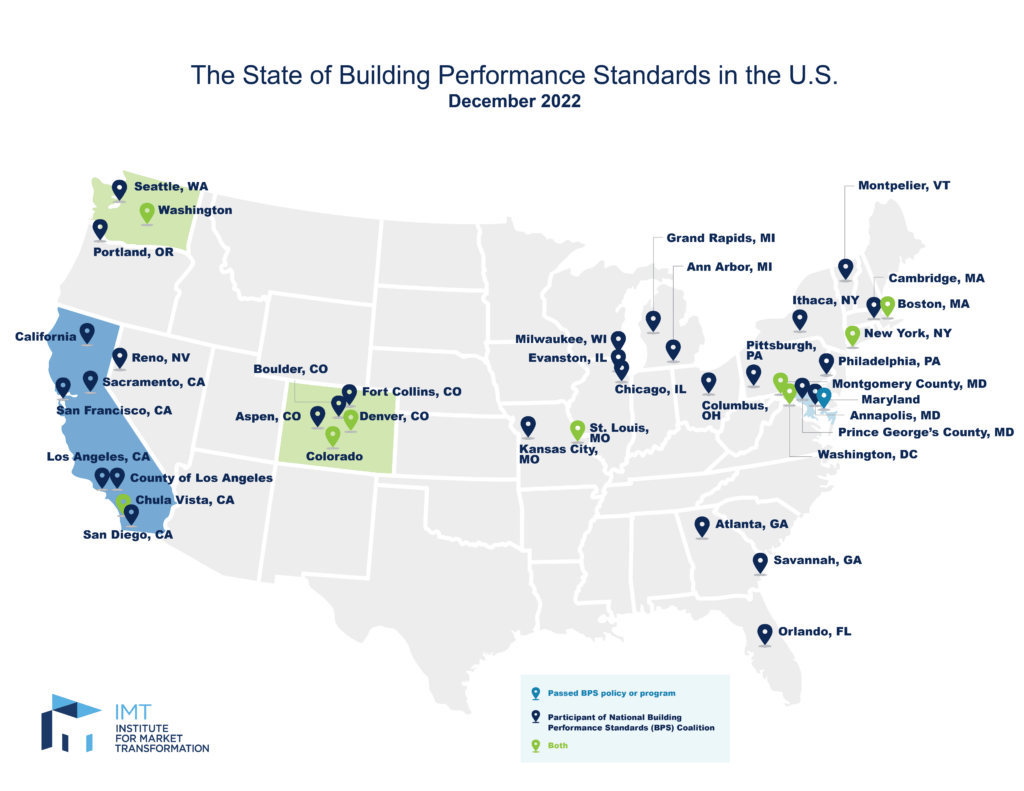The early December announcement from the White House was an exciting moment for those of us invested in the fight to combat climate change, particularly related to the built environment. The two-fold announcement included the following:
- A Federal Building Performance Standard (BPS) has been set forth to electrify 30% of Government-owned building square footage by 2030.
- The State of California has joined the National BPS Coalition, a nationwide group of over 35 state and local governments that have committed to reducing their emissions footprint and improving the performance of existing buildings by 2024.
Whether or not you own or operate in California, you need to pay attention to the National BPS Coalition. Currently 4 states, 3 counties, and 33 cities have made a commitment to implementing BPS by 2024 and 10 have already passed the policy. Buildings in these jurisdictions provide significant, long-term opportunities for the commercial real estate industry at large.

If you are a building owner or building performance contractor, you may be wondering what this all means in general and what it might mean for you. To help break it down, here are the top reasons why these two actions matter:
- As the Coalition continues to grow and BPS roll out across the country, the financial risk for non-compliance, which can be significant, will be a critical element of ESG reporting and risk management. This is also known as a transition risk of climate change.
- The Federal BPS is requiring Federal buildings to lead the way in electrification, and calls for elimination of on-site fossil fuels (scope 1 emissions) in 30% of all federal buildings by 2030. History has shown us that when the U.S. General Services Administration (GSA) makes a bold move in their owned portfolio, it is highly influential in affecting the private market. Notable examples include the usage of ENERGYSTAR and LEED certifications.
- Electrification is not immediately feasible for every Federal agency building, which is why the immediate focus is on 30% of the government-owned square footage, new properties, and those undergoing significant renovations. As budgets and priorities shift towards climate crisis, the remainder of the Federal stock will be addressed. This is a significant change for the industry, and at this national scale it can open doors to new technologies, job creation, and opportunities to stimulate local economies.
- This major move towards electrification will also help create greater market demand for effective technologies. Manufacturers and service providers have the opportunity to drive economies of scale and ultimately lower prices for the overall market over time.

- These commitments from the Federal Government and California represent an unprecedented opportunity for equitable workforce development. New jobs, particularly in areas with large Federal campuses, can stimulate economic growth and set people on a career path in sustainability. Although it hasn’t been explicitly outlined, IMT hopes that the Federal investments will be covered under the Justice40 Initiative. This specifies that 40% of the benefits of investments in areas like climate change, energy efficiency, training, and reduction of pollution will be allocated to frontline communities.
- When jurisdictions pass a BPS, there will be new regulations that building owners, managers, and contractors will have to navigate. Many of these local governments are setting up High-Performance Building Hubs to provide technical assistance. Connecting with a Hub is a great way to ensure your buildings comply with new emissions and electrification policies.
- BPS provide a significant opportunity for existing energy service contractors to grow their business while helping building owners drive performance and reduce risk. The Federal government currently awards 5% of contracts to Women-Owned Small Businesses (WOSB) and Economically Disadvantaged Women-Owned Small Businesses (EDWOSB). Ideally, the Federal BPS will make more significant investments in these businesses as contracts are posted.
- Buildings that don’t start strategically planning now for decarbonization and electrification throughout the building’s life cycle may end up having to invest unexpected large amounts of capital later to meet new market and policy standards. IMT strongly recommends strategically investing now in your new development, major renovations, and system replacements to reduce financial/transition risk and ensure long-term building value.
IMT is the go-to expert for understanding this ever-expanding landscape of building performance standards and what it means for buildings and businesses. If you have any interest in learning more or plugging into our Corporate Engagement Opportunity (CEO) program to receive insights, training, and educational materials on climate-related building policies and trends reach out to Marla Thalheimer.
